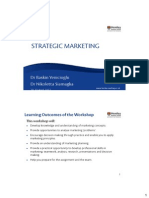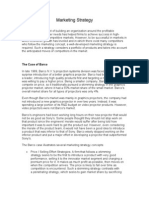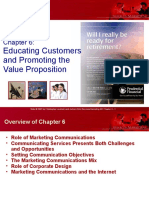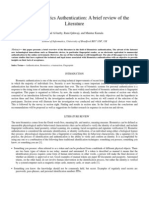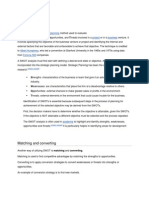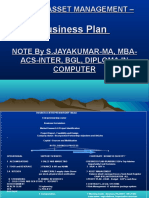Princinples of Strategic Marketing Management
Princinples of Strategic Marketing Management
Uploaded by
Zain LakdawalaCopyright:
Available Formats
Princinples of Strategic Marketing Management
Princinples of Strategic Marketing Management
Uploaded by
Zain LakdawalaCopyright
Available Formats
Share this document
Did you find this document useful?
Is this content inappropriate?
Copyright:
Available Formats
Princinples of Strategic Marketing Management
Princinples of Strategic Marketing Management
Uploaded by
Zain LakdawalaCopyright:
Available Formats
MOHAMMED ZAIN LAKDAWALA ML7461IN DMS AND MBA WILLIAMS COLLEGE
TABLE OF CONTENT: INTRODUCTION.................................................................................................................1 1.1 ROLE OF STRATEGIC MARKETING......................................................................1 1.2 PROCESSES INVOLVED IN MARKETING.............................................................3 1.3 LINKS BETWEEN STRATEGIC PLANNING &CORPORATE STRATEGY.....3 2.1 VALUE OF MODELS IN STRATEGC MARKETING.............................................4 2.2 MARKETING TACTIC AND STRATEGIC POSITIONING..................................8 2.3 MERITS OF RELATIONSHIP MARKETING..........................................................9 3.1 MARKETING TECHNIQUES....................................................................................10 3.2 MARKETINH STRATEGY OPTIONS......................................................................12 3.3 MARKETING OBJECTIVES.....................................................................................14 4.1 CHANGES IN EXTERNAL ENVIRONMENT........................................................15 4.2 INTERNAL ANALYSIS..............................................................................................15 4.3 MARKETING RESPONSES.......................................................................................15 REFERENCING .................................................................................................................19
MOHAMMED ZAIN LAKDAWALA ML7461IN DMS AND MBA WILLIAMS COLLEGE
AIMS AND OBJECTIVES: To understand and develop the skills to support active engagement in the process of strategic marketing management.
Introduction: Marks & Spencer, founded in 1884 by Michael Marks and Thomas Spencer, is one of the UK's foremost retailers of clothing, foods, homeware and financial services, boasting a weekly customer base of 10 million in over 300 UK stores. Marks & Spencer operate in 30 countries worldwide, and has a group turnover in excess of lb8 billion. It has specific values, missions and visions. It's main vision is 'to be the standard against which all others are measured', it's main mission is 'to make aspirational quality accessible to all', and it's main values are quality, service, innovation and trust. (www.marksandspencer.co.uk). The purpose of this assignment is to construct a SWOT analysis, highlighting each of the strengths, weaknesses, opportunities and threats that were highlighted in the internal audit. Conclusions will be drawn from the SWOT analysis, which will attempt to review the company's position and identify the marketing priorities. Also, Marks & Spencer's recent marketing activities will be critically analysed in order to ascertain what improvements have been made since 1998.This assignment will attempt to determine why Marks & Spencer nearly collapsed and what they have achieved in terms of success and failure as part of their recovery programme. Marks & Spencer is a perfect example of a company that had a successful strategy but failed to adapt to the changing environment and have therefore suffered from 'strategic wear-out.
MOHAMMED ZAIN LAKDAWALA ML7461IN DMS AND MBA WILLIAMS COLLEGE
PRINCINPLES OF STRATEGIC MARKETING MANAGEMENT. 1.1 Role of strategic marketing: In the fast-moving world of business, definitions rarely stay the same. Marketing has been described as The management process responsible for identifying, anticipating and satisfying customer requirements profitably. The Chartered Institute of Marketing (CIM) proposed new definition of marketing, which is: 'The strategic business function that creates value by stimulating, facilitating and fulfilling customer demand. "Good companies will meet needs; great companies will create markets," says Philip Kotler.
The role of strategic marketing is to develop a strategy to cope with competitors, identify market opportunities, develop and commercialize new products and services, allocate resources among marketing activities and design an appropriate organizational structure to ensure the performance desired is achieved. (http://www.staffs.ac.uk/courses_and_study/courses/cim-professional-postgraduate-diplomain-marketing-tcm4231875.jsp) A marketing plan provides you with an in-depth perspective of your industry and your business and gives you insight on developing targeted market strategies while also serving as a barometer of your performance. Moreover, a marketing plan allows you to examine and reexamine your marketing objectives and provides the basis for your marketing decisions.
MOHAMMED ZAIN LAKDAWALA ML7461IN DMS AND MBA WILLIAMS COLLEGE
A marketing plan is useful to many people in a business. It can help to: Identify sources of competitive advantage Gain commitment to a strategy Get resources needed to invest in and build the business Inform stakeholders in the business Set objectives and strategies Measure performance 1.2 Processes involved in strategic planning:
The process involves thinking about every step the company takes to sell, service and manage the customers. The following points are the key to this process: 1. The knowledge of the market and the strategy to penetrate it. 2. The distribution channels that the company uses to connect with the customers . 3. The pricing strategy of the company is also a key element. 4. The messages that the company delivers to its market. 5. The look and feel of the companys marketing materials 6. The experience that the company delivers to its market and customers 7. The actions of the companys sales and service representatives. 8. All of the planning, preparation, forecasting and measurement of the companys investments.
1.3 Links between strategic marketing and corporate strategy:
MOHAMMED ZAIN LAKDAWALA ML7461IN DMS AND MBA WILLIAMS COLLEGE
Porter devised seven steps to tackle this: 1. As competition takes place at the business unit level, identify the interrelationships between the existing business unit levels. 2. Identify the core business which is to be foundation of the business strategy. 3. Create horizontal organizational mechanism to facilitate interrelationships among core businesses. 4. Pursue diversification opportunities that allow shared activities and pass all three crucial steps. 5. Pursue diversification through transfer of skills if opportunities for sharing activities are limited or exhausted. 6. Pursue a strategy of restructuring if this fits the skills of management or if no good opportunities exist for forgoing business partnerships. 7. Pay dividends so that shareholders can become portfolio managers.
MOHAMMED ZAIN LAKDAWALA ML7461IN DMS AND MBA WILLIAMS COLLEGE
2.1 Assess the value of models used in strategic marketing planning: SWOT analysis of Marks and Spencer Strengths Sales of clothes have stabilised, and food sales have increased New chief executive with fresh ideas and sales led growth Good advertising Used iconic models to attract core target group. George Davies Product diversification home and furniture Turnaround in sales and growth Weaknesses Resignation of three key members of staff: George Davies, finance director; Andrea White and Melanie Davies head of merchandising Previous poor performance, seven straight quarters of falling sales More expensive than other high street stores limited market. Focusing on older generation may lose younger market.
MOHAMMED ZAIN LAKDAWALA ML7461IN DMS AND MBA WILLIAMS COLLEGE
Opportunities Rebuild the companys image with continued advertising such as the successful M & S food adverts Focus on core market UK has an ageing population Introducing wider ranges such as Per Una, Autograph and Classic collection to stores Use younger more contemporary models to attract younger generation. Internet food shopping but opportunities may be limited Other services eg banking, insurance, savings etc.
Threats Previously tarnished reputation and image Competitor product ranges which directly compete with M & S food such as Tesco finest Decline of the high street May lose youth market General increase in internet shopping Social tastes Branding
2.2 Link between strategic positioning and marketing tactic:
Marketing 4 Ps:
1. Product - The product aspects of marketing deal with the specifications of the actual goods or services, plus how it relates to the end users needs and wants. The range of a product normally includes supporting elements such as warranties, guarantees, and support.
MOHAMMED ZAIN LAKDAWALA ML7461IN DMS AND MBA WILLIAMS COLLEGE
2. Pricing -This refers to the process of setting a price for a product, together with discounts. The price need not be monetary; it can plainly be what is exchanged for the product or services, e.g. time, energy, or attention. Methods of setting prices optimally are in the domain of pricing art 3. Placement this refers to how the product gets to the buyer; for instance, point-of-sale assignment or retailing. This third P has furthermore at times been called Place, referring to the channel by which a product or service is sold (e.g. online vs. retail), which geographic region or industry, to which division (young adults, families, business citizens), etc. also referring to how the surroundings in which the product is sold in can influence sales.
4. Promotion - This includes advertising, sales promotion, including promotional education, publicity, and individual selling. Branding refers to the assorted strategies of promoting the product, brand, or company. 2.3MERITS OF RELATIONSHIP MARKETING: A key aspect of customer relationship marketing (CRM) is building up a strong sense of trust and respect between the business and, the most important stakeholder, the customer and aims to increase sales from retaining customers rather than constantly penetrating the same market over and over again. This is an approach that has worked well for Marks and Spencer (M&S), the retailer. According to a YouGov survey, commissioned by the marketing agency Baber Smith, M&S continues to be Britains most trusted retailer for the second year in a row; what generates such trust has been identified as having a good reputation.
MOHAMMED ZAIN LAKDAWALA ML7461IN DMS AND MBA WILLIAMS COLLEGE
So how has M&S gained such success in their CRM? Much of it is down to a consistent ownlabel product range and not an older, middle-class market segment. M&S has become a market leader in semi-prepared, own-brand dishes that have been supported through highprofile above the line TV advertisements. This means the ill-conceived perception that own-brand equals inferior has been broken down, increasing their reputation and thus boosting trust. Moreover, all retailers have direct contact with their customers and can use management information systems, using data from loyalty cards and direct feedback, to match their new product development to consumer needs. Consequently, own-brand labels have become differentiated by tapping into unfulfilled niches. Ultimately, the fundamental goal is achieved: increased sales revenue.
(http://manifestedmarketing.wordpress.com/2010/07/23/marks-and-spencers-customerrelationship-marketing/) 3.1 STRATEGIC MARKETING TECHNIQUES: Here are 5 successful marketing techniques to increase sales. All of them are simple to use. And they're effective for building any businesses
MOHAMMED ZAIN LAKDAWALA ML7461IN DMS AND MBA WILLIAMS COLLEGE
1. Keep Adding Something New Every time the company adds something new to the business, it creates an opportunity to get more sales.
The added product increases the sales in 3 different ways:
It attracts new customers who were not interested in your current products and services.
It generates repeat sales from existing customers who also want to have the new product.
It enables the company to get bigger sales by combining 2 or more items into special package offers.
2. Become a Valuable Resource The company should look for ways it can be a resource for the companys prospects and customers. The company should provide the customers with free information. Help them do things faster, easier, less expensively. The company gets another opportunity to sell something every time they come back to the company for help.
3. Separate from Competition The company must find or create a reason for customers to do business with it instead of with someone else offering the same or similar products. The company must determine the unique advantage it offers to customers that its competitors do not offer. Promote that advantage in all of its advertising. The company must give its prospects a reason to do business with itslef instead of with its competition and the company will automatically get more sales.
4. Promote the End Result The customers don't really want the comanys product or service. They want the benefit
MOHAMMED ZAIN LAKDAWALA ML7461IN DMS AND MBA WILLIAMS COLLEGE
produced by using it. The company must make sure its web pages, sales letters and other sales messages are promoting the end result its customers want.
5. Anticipate Change Change is the biggest challenge to the success of the business. The days are gone when a business could constantly grow by simply repeating what it did successfully in the past or even recently. Aggressive, innovative competitors and rapidly changing technology make it impossible. The company should expect change and be prepared for it. It should not wait until its income declines to take action. The company must develop the habit of looking for early signs that something is changing. Then it should confront it before it starts to lose business.
3.2 Strategy Options: (http://en.wikipedia.org/wiki/Porter_generic_strategies) Porters Generic strategy: Porter has described a category scheme consisting of three general types of strategies that are commonly used by businesses to achieve and maintain competitive advantage. These three generic strategies are defined along two dimensions: strategic scope and strategic strength. He originally ranked each of the three dimensions as either low, medium, or high, and juxtaposed them in a three dimensional matrix. That is, the category scheme was displayed as a 3 by 3 by 3 cube. But most of the 27 combinations were not viable.
MOHAMMED ZAIN LAKDAWALA ML7461IN DMS AND MBA WILLIAMS COLLEGE
Cost Leadership Strategy This strategy involves the firm winning market share by appealing to cost-conscious or pricesensitive customers.
Differentiation Strategy Differentiate the products in some way in order to compete successfully.
Shell Directional Policy Matrix: The Shell Directional Policy Matrix is another refinement upon the Boston Matrix. Along the horizontal axis areprospects for sector profitability, and along the vertical axis is a company's competitive capability. As with the GE Business Screen the location of a Strategic Business Unit (SBU) in any cell of the matrix implies different strategic decisions. However decisions often span options and in practice the zones are an irregular shape and do not tend to be accommodated by box shapes. Instead they blend into each other.
MOHAMMED ZAIN LAKDAWALA ML7461IN DMS AND MBA WILLIAMS COLLEGE
(http://marketingteacher.com/lesson-store/lesson-shell-directional-policy-matrix.html)
Each of the zones is described as follows:
Leader - major resources are focused upon the SBU. Try harder - could be vulnerable over a longer period of time, but fine for now.
Double or quit - gamble on potential major SBU's for the future. Growth - grow the market by focusing just enough resources here. Custodial - just like a cash cow, milk it and do not commit any more resources.
Cash Generator - Even more like a cash cow, milk here for expansion elsewhere.
Phased withdrawal - move cash to SBU's with greater potential. Divest - liquidate or move these assets on a fast as you can.
3.3 Strategic marketing objectives: Marketing mix-7 ps:
MOHAMMED ZAIN LAKDAWALA ML7461IN DMS AND MBA WILLIAMS COLLEGE
(http://marketingteacher.com/lesson-store/lesson-marketing-mix.html) The marketer mixes the prime colours (mix elements) in different quantities to deliver a particular final colour. Every hand painted picture is original in some way, as is every marketing mix. Some commentators will increase the marketing mix to the Five P's, to include people. Others will increase the mix toSeven P's, to include physical evidence (such as uniforms, facilities, or livery) and process . Price There are many ways to price a product. The beat price would be the one that gives the best value to the customer. Place Another element of Neil H.Borden's Marketing Mix is Place. Place is also known as channel, distribution, or intermediary. It is the mechanism through which goods and/or services are moved from the manufacturer/ service provider to the user or consumer. Product For many a product is simply the tangible, phsysical entity that they may be buying or selling. Promotion Another one of the 4P's is promotion. This includes all of the tools available to the marketer for 'marketing communication'. As with Neil H.Borden's marketing mix, marketing
MOHAMMED ZAIN LAKDAWALA ML7461IN DMS AND MBA WILLIAMS COLLEGE
communications has its own 'promotions mix.' Think of it like a cake mix, the basic ingredients are always the same. Physical Evidence Physical Evidence is the material part of a service. Strictly speaking there are no physical attributes to a service, so a consumer tends to rely on material cues. People People are the most important element of any service or experience. Services tend to be produced and consumed at the same moment, and aspects of the customer experience are altered to meet the 'individual needs' of the person consuming it. Process Process is another element of the extended marketing mix, or 7P's.There are a number of perceptions of the concept of process within the business and marketing literature.
Task 4: 4.1 Changes in external environment:
All of those (political, economic, social, technical, legal and environmental) factors will to some extent apply to the retail industry UK. POLITICAL Following the European Integration and Free Trade Agreements, the market has opened up for British Companies to invest in Eastern Europe. ECONOMIC - the Retail sector is fairly recession prawn and also very sensitive to changes in interest rates. Since the events of September 11th the world economies have suffered heavily, stocks plummeted and prices are at all time lows. The world economy is however, now on the up post September 11th. Consumers are optimistic and the retail industry is once again booming. SOCIAL changes in consumer taste and lifestyle represent both opportunities and threats for the industry. Opportunities in terms of new market and consumers, however, there are added threats in terms of social acceptance to alcohol TECHNICAL Changes in retailing methods as such clothes sales via the Internet is now a common place in retailing. Paperless operation, the management and administration of the company are undertaken on IT systems, which are accessed through secure servers; provide flexibility in the running of the business.
MOHAMMED ZAIN LAKDAWALA ML7461IN DMS AND MBA WILLIAMS COLLEGE
LEGAL National legislation for health and safety both in terms of consumer rights and also in terms of production of own natural renewable resources for making clothes. ENVIRONMENTAL The renewable source of resources used in production, namely cotton and wool are environmentally friendly. The threats are in terms of legal consequences for livestocks in terms of health and safety. 4.2 and An internal analysis: M&S has a very strong corporate identity.
Well-known retail brand name clear image and style Protective corporate principles and culture Theory Z Self esteem and pride.
In some situations, however, M&S has been forced to renege on its principles. For example, when it closed some stores in France, it was apparently unable to provide the level of job protection and benefits that M&S employees have come to expect. M&S did not even manage to comply with French law in the way they consulted staff about the closures, leaving them open to accusations of corporate irresponsibility. These charges wounded a company that prides itself on going beyond the letter of the law. 4.3 Strategic Marketing Responses:
a) Total focus on UK retail
The Company will only own brand products and brands exclusive to M&S so it can guarantee customers the quality, value and service they have come to expect.
Recovery plan for Clothing
The Company has plans to regain the confidence of its customers in the quality and fit of its clothing. It will sharpen pricing by rebalancing the price architecture, extending the range of entry-price merchandise and communicating this clearly to customers.
MOHAMMED ZAIN LAKDAWALA ML7461IN DMS AND MBA WILLIAMS COLLEGE
Expansion in growing product areas such as Food, Home and Beauty
M&S Foods continues to perform well and has earned customers' trust for providing quality, innovation and convenience. The business is a key platform for future growth and the Company is considering opportunities to expand its reach through new locations and selling channels.
The Home business is growing strongly, with home furnishings and gifts the fastest growing product areas. Beauty, albeit relatively small, is also growing rapidly. Both of these areas offer promising opportunities for development and will be expanded.
Accelerate Store Renewal Programme: M&S will accelerate the rollout of the successful elements of its new concept format under a plan to refurbish more stores faster and at lower cost.
More intensive use of space
Selling space will be reallocated to higher growth product areas to maximise returns per square foot.
Being closer to the customer
In order to be more customer oriented, some stores in big cities will be opened 24 hours per day.
MOHAMMED ZAIN LAKDAWALA ML7461IN DMS AND MBA WILLIAMS COLLEGE
b) Value realisation, cost cutting measures and closure of loss-making businesses In order to focus all its efforts on the recovery of the UK business, Marks & Spencer intends to divest or close non-core businesses and assets, subject to consultation with its employees.
Conclusion A competitive market system creates incentives for firms to vie for large market shares. Sometimes one firm is so successful in this fight, it acquires a dominant position in a market. From the firm's point of view, a large market share is good. After all, dominance implies power and control. It creates a real potential to increase profits. From society's point of view, however, dominance may not be quite so desirable. For the power that goes with dominance can be acquired and used in a number of ways.. In the case of Marks & Spencer, it has successfully gained the upper hand on the race for global dominance. By utilizing the many factors and the pros and cons of the theory, Marks & Spencer is effectively making a good marketing strategy.
Recommendations
Marks and Spencer has become extra selling space and opening out-of-town stores to shift surplus stock. It is a tough time for the company and also the right time for a new broom. Marks and Spencer should get lessons from past and look at more about what is happening in the market place and change itself from the old way of doing things to a brandnew image in order to sustain its competitive advantage and regain its leading position in terms of management effectiveness.
MOHAMMED ZAIN LAKDAWALA ML7461IN DMS AND MBA WILLIAMS COLLEGE
REFERNCING: http://en.wikipedia.org/wiki/Marketing_strategy(accessed on 25th December 2010) http://en.wikipedia.org/wiki/Marks_%26_Spencer#Marketing (accessed on 26th December 2010) http://manifestedmarketing.wordpress.com (accessed on 25th December 2010) http://www.marksandspencer.com (accessed on 24th December 2010) www.businessballs.com (accessed on 25th December 2010)
Hasting H- Improve your marketing to grow your business: insights and innovation that drive business and brand ( Wharton school pub, 2008) pages 12-36 Kotler P- Principles of marketing, International edition(edition 2008) pages 23-67
You might also like
- Mini-Case Insight Into Consumer Decision Making For TVs FinalDocument4 pagesMini-Case Insight Into Consumer Decision Making For TVs FinalPritam BhowmickNo ratings yet
- Pcem 06 Swot Analysis Kaha FinalDocument23 pagesPcem 06 Swot Analysis Kaha Finalziad0% (1)
- It Strategy Mobitel L.S.A.Y.I. Siriwardhana Mba - 13 - 3365Document7 pagesIt Strategy Mobitel L.S.A.Y.I. Siriwardhana Mba - 13 - 3365Nuwan WeerasekaraNo ratings yet
- Project Proposal: "Revolutionary Solutions For in Building Coverage Solution & Implementation of The Same"Document4 pagesProject Proposal: "Revolutionary Solutions For in Building Coverage Solution & Implementation of The Same"Viraaj ShahNo ratings yet
- Strategy Mark N SpencerDocument4 pagesStrategy Mark N SpencerShalabh AggarwalNo ratings yet
- Key Questions For Telecom CTODocument4 pagesKey Questions For Telecom CTOMahesh GovindNo ratings yet
- Running Head: MANAGEMENT 1: Space, Grand, and QSP Matrices Analysis Student's Name Institution AffiliationDocument6 pagesRunning Head: MANAGEMENT 1: Space, Grand, and QSP Matrices Analysis Student's Name Institution AffiliationSam OburuNo ratings yet
- Corporate Communications: A Dimension of Corporate MeaningDocument21 pagesCorporate Communications: A Dimension of Corporate MeaningZain Lakdawala100% (1)
- Beacon House ReportDocument23 pagesBeacon House ReportRacing Sangers100% (4)
- FORMAT of Internship Report - PADI619Document4 pagesFORMAT of Internship Report - PADI619Imran RiazNo ratings yet
- VodafoneDocument34 pagesVodafoneazwaniemonastNo ratings yet
- Tools of Environmental Analysis in Strategic ManagementDocument8 pagesTools of Environmental Analysis in Strategic Managementsejal SasteNo ratings yet
- HB 45 STMK Handout SlidesDocument56 pagesHB 45 STMK Handout SlidesJoy NaidooNo ratings yet
- Mobile Content PlatformsDocument25 pagesMobile Content PlatformsSatyendra SinghNo ratings yet
- Lecture 2 - Planning The Sales Team's EffortsDocument105 pagesLecture 2 - Planning The Sales Team's EffortsHiếu Nguyễn HùngNo ratings yet
- Statement of Problem On Mobile CommerceDocument24 pagesStatement of Problem On Mobile Commerceally jumanneNo ratings yet
- CaseDocument13 pagesCaseKanishak ChauhanNo ratings yet
- CH 4 Strategy Formulation & ImplementationDocument27 pagesCH 4 Strategy Formulation & ImplementationMahmoud MohamedNo ratings yet
- Marketing Strategy: The Case of BarcoDocument5 pagesMarketing Strategy: The Case of BarcoParvinder KumarNo ratings yet
- LoveLock Chapter 6Document71 pagesLoveLock Chapter 6TanvirNo ratings yet
- 1.1. Marketing ResearchDocument22 pages1.1. Marketing ResearchAnamika Rai PandeyNo ratings yet
- Sales SupportDocument140 pagesSales SupportResylyn CabreraNo ratings yet
- Case Analysis - Instruction - DBA - Case AnalysisDocument6 pagesCase Analysis - Instruction - DBA - Case AnalysisHương HoàngNo ratings yet
- HRM - Case Study 3 - A Case of Racial DiscriminationDocument6 pagesHRM - Case Study 3 - A Case of Racial DiscriminationArren KhanNo ratings yet
- Deloitte Maverick: A Study and Analysis of The US Telco CaseDocument11 pagesDeloitte Maverick: A Study and Analysis of The US Telco CaseNikhil SharmaNo ratings yet
- Moblink Efe CPM IfeDocument4 pagesMoblink Efe CPM IfeHina Sikander0% (1)
- Secure Biometrics Authentication: A Brief Review of The Literature, Fahad Al-HarbyDocument7 pagesSecure Biometrics Authentication: A Brief Review of The Literature, Fahad Al-Harbyharbyf100% (4)
- Factors Affecting Customer Satisfaction in Telecommunication Sector in NepalDocument62 pagesFactors Affecting Customer Satisfaction in Telecommunication Sector in NepalAyush Man TamrakarNo ratings yet
- Value Chain AnalysisDocument18 pagesValue Chain AnalysisjainsonaNo ratings yet
- Swot AnalysisDocument13 pagesSwot AnalysisEr Paras ThakurNo ratings yet
- International Marketing Review: Article InformationDocument24 pagesInternational Marketing Review: Article InformationwebaexportmoncefNo ratings yet
- Basics of CRM & CRM Types: A Brief Introduction To Customer Relationship ManagementDocument18 pagesBasics of CRM & CRM Types: A Brief Introduction To Customer Relationship ManagementPhilip AtkinsonNo ratings yet
- How Telecom Operators in Africa Are Failing Persons With DisabilitiesDocument23 pagesHow Telecom Operators in Africa Are Failing Persons With DisabilitiesAfrican Centre for Media ExcellenceNo ratings yet
- MSC Computer ScienceDocument36 pagesMSC Computer ScienceRakesh Padiyath67% (3)
- Evaluation of The Impact External Factors Could Have On Tesco PLC For Future ProspectsDocument7 pagesEvaluation of The Impact External Factors Could Have On Tesco PLC For Future ProspectsJody Mc LaughlinNo ratings yet
- Integrating Healthcare Services, Part 1:: Using An Enterprise Service Bus For HealthcareDocument18 pagesIntegrating Healthcare Services, Part 1:: Using An Enterprise Service Bus For HealthcaredikshithamNo ratings yet
- Some Marketers Feel That The Image of The Particular Channel in Which They Sell Their Products Does Not Matter-AllDocument1 pageSome Marketers Feel That The Image of The Particular Channel in Which They Sell Their Products Does Not Matter-AllHarriet BlaireNo ratings yet
- Innovation in Telecommunication ServicesDocument44 pagesInnovation in Telecommunication ServicesSaurabhNo ratings yet
- Marketing ResearchDocument4 pagesMarketing ResearchMohit TyagiNo ratings yet
- Research Methods For Strategic ManagersDocument5 pagesResearch Methods For Strategic ManagersAyesha Sarfaraz0% (3)
- SDM NotesDocument21 pagesSDM Notesakash100% (1)
- New LeanDocument28 pagesNew LeanAnimesh ShankarNo ratings yet
- MMC Pricing Elasticity Analysis June2011Document17 pagesMMC Pricing Elasticity Analysis June2011Carlos ValdecantosNo ratings yet
- Cemex Transforming A Basic Industry CompanyDocument5 pagesCemex Transforming A Basic Industry CompanyManoj Doley0% (1)
- The Contribution of Advertising Agencies Towards Effective Marketing of Goods andDocument62 pagesThe Contribution of Advertising Agencies Towards Effective Marketing of Goods andneoeverest100% (3)
- Growth Possibilities For US TelcoDocument9 pagesGrowth Possibilities For US TelcoAnkit GoyalNo ratings yet
- Strategic Relation Supply Chain and Product Life Cycle: January 2014Document9 pagesStrategic Relation Supply Chain and Product Life Cycle: January 2014Tanvir HossainNo ratings yet
- West Faded FlamesDocument10 pagesWest Faded FlamesAbhijeet PatilNo ratings yet
- Generic Strategy - CriticismDocument15 pagesGeneric Strategy - Criticismpratyush parmar0% (1)
- VodafoneDocument35 pagesVodafoneGleb Nerzin50% (2)
- Project Title "'Analysis of Profitability of Banks: Comparative Study of Private and Public Sector Bank''Document55 pagesProject Title "'Analysis of Profitability of Banks: Comparative Study of Private and Public Sector Bank''ProsNo ratings yet
- MB0030 Marketing ManagementDocument289 pagesMB0030 Marketing Managementari811No ratings yet
- SWOT ANALYSIS of Telecom CompaniesDocument8 pagesSWOT ANALYSIS of Telecom CompaniessurajitbijoyNo ratings yet
- MNP StrategyDocument1 pageMNP StrategycaprisrulzNo ratings yet
- SWOT AnalysisDocument16 pagesSWOT Analysisrizwansaeed73No ratings yet
- Ijert Ijert: Online Insurance Management SystemDocument4 pagesIjert Ijert: Online Insurance Management SystemPallavi PalluNo ratings yet
- Business Strategy For 1298Document20 pagesBusiness Strategy For 1298Aniket Pallav0% (1)
- FMC fixed-mobile convergence Complete Self-Assessment GuideFrom EverandFMC fixed-mobile convergence Complete Self-Assessment GuideNo ratings yet
- SMU A S: Sales Distribution & Supply Chain ManagementDocument27 pagesSMU A S: Sales Distribution & Supply Chain ManagementGYANENDRA KUMAR MISHRANo ratings yet
- Marketing Management B3Document3 pagesMarketing Management B3Shems NebizadeNo ratings yet
- Course Outline - Sales Management-SZABISTDocument6 pagesCourse Outline - Sales Management-SZABISTSarmad KheroNo ratings yet
- Unit 7 - Strategic Human Marketing ManagementDocument10 pagesUnit 7 - Strategic Human Marketing ManagementHashir AslamNo ratings yet
- EA Brief 5013 Ver1Document5 pagesEA Brief 5013 Ver1Zain Lakdawala0% (1)
- Agency HanDocument7 pagesAgency HanZain LakdawalaNo ratings yet
- HRM FinalDocument16 pagesHRM FinalNiloy BiswasNo ratings yet
- InnovationDocument7 pagesInnovationZain LakdawalaNo ratings yet
- Healthcare MarketingDocument98 pagesHealthcare MarketingZain Lakdawala0% (1)
- HRM Assignment HumDocument14 pagesHRM Assignment HumZain Lakdawala100% (3)
- Strategic Change ManagementDocument14 pagesStrategic Change ManagementZain Lakdawala50% (2)
- Business Strategy 23.33Document25 pagesBusiness Strategy 23.33Zain LakdawalaNo ratings yet
- Acas How To Manage Change Advisory BookletDocument44 pagesAcas How To Manage Change Advisory BookletMARIOLA.MIGUELNo ratings yet
- Business Plan EntrepDocument19 pagesBusiness Plan EntrepJeff Malveda CastilloNo ratings yet
- College of Business and Economics University of JohannesburgDocument15 pagesCollege of Business and Economics University of JohannesburgZizo ZinathiNo ratings yet
- Developing A Knowledge Strategy: Michael H. ZackDocument21 pagesDeveloping A Knowledge Strategy: Michael H. ZackyasserNo ratings yet
- Term Paper: Bangladesh University of Professionals (Bup)Document5 pagesTerm Paper: Bangladesh University of Professionals (Bup)Muslima Mubashera Reza RupaNo ratings yet
- 19384-Article Text-65836-1-10-20220425Document16 pages19384-Article Text-65836-1-10-20220425Toufiq ReinaldyNo ratings yet
- Linkage Between HRM With Business StrategyDocument22 pagesLinkage Between HRM With Business Strategymuhammad100% (5)
- Netflix in 2012 Can It Recover From Its Strategy MissteptsDocument1 pageNetflix in 2012 Can It Recover From Its Strategy MissteptsShubham GoelNo ratings yet
- Team Innov8s Executive PresentationDocument12 pagesTeam Innov8s Executive Presentationapi-561877895No ratings yet
- Hotel Asset Management Business PlanDocument18 pagesHotel Asset Management Business PlanNguyễn Thế PhongNo ratings yet
- CSM Individual AssignmentDocument8 pagesCSM Individual AssignmentTaza KalambataNo ratings yet
- A Comprehensive Method For Assessment of Operational Risk in E-BankingDocument7 pagesA Comprehensive Method For Assessment of Operational Risk in E-BankingMohamed Mahdi MouhliNo ratings yet
- Etps Feasibility ReportDocument71 pagesEtps Feasibility ReportSandeep Kumar YadavNo ratings yet
- Individual Marketing AssignmentDocument20 pagesIndividual Marketing AssignmentNeha Dobee100% (2)
- Feasibility Study of Gypsum Products VF SubmittedDocument24 pagesFeasibility Study of Gypsum Products VF SubmittedKayo AbebeNo ratings yet
- Internship ReportDocument51 pagesInternship ReportRashid Hussain Wadho0% (1)
- OBS 124 Unit 2 - Manager As Planner and Strategist - Final 2023Document40 pagesOBS 124 Unit 2 - Manager As Planner and Strategist - Final 2023Lungelo Maphumulo100% (1)
- Unit 27: Identifying Entrepreneurial OpportunitiesDocument19 pagesUnit 27: Identifying Entrepreneurial OpportunitiesParama SahaNo ratings yet
- Presentation - Accor Take Off - Lifting WINGS To Local CommunityDocument38 pagesPresentation - Accor Take Off - Lifting WINGS To Local CommunityLe Pham HuyenNo ratings yet
- Hugot BurgerDocument10 pagesHugot BurgerRoselle MalabananNo ratings yet
- Product Operation Management PPT (Unit 1&2)Document110 pagesProduct Operation Management PPT (Unit 1&2)Sudhir Singh100% (2)
- Strat Man Final ProjectDocument60 pagesStrat Man Final ProjectAnisha KirlewNo ratings yet
- Swot Analysis of Tata Group: Presented By: Flocim Gabriel DsouzaDocument14 pagesSwot Analysis of Tata Group: Presented By: Flocim Gabriel DsouzaSimranAhluwaliaNo ratings yet
- Strategy Formulation: SWOT Analysis TOWS MatrixDocument19 pagesStrategy Formulation: SWOT Analysis TOWS MatriximuffysNo ratings yet
- Ujian Skripsi AnggunDocument24 pagesUjian Skripsi Anggunana miftaNo ratings yet
- Managerial Decision Making Report XXXDocument79 pagesManagerial Decision Making Report XXXNichole John ErnietaNo ratings yet
- Foundation Assignment PrintedDocument30 pagesFoundation Assignment PrintedGeethika SenavirathneNo ratings yet












